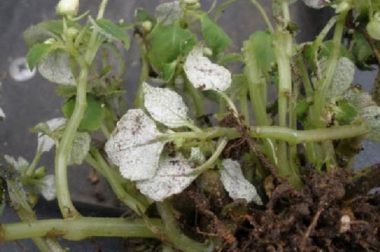
What is impatiens downy mildew?
Impatiens downy mildew is a serious threat wherever impatiens are grown, including Wisconsin. Impatiens downy mildew has been so destructive in the past that it has made impatiens unusable as a garden ornamental. The disease affects garden impatiens (Impatiens walleriana and I. balsamina), as well as native jewelweeds (I. pallida and I. capensis). New Guinea impatiens (I. hawkerii) and its hybrids appear to be either resistant to or tolerant of the disease. Other common garden ornamentals are immune to impatiens downy mildew and thus not affected by the disease.
What does impatiens downy mildew look like?
Symptoms of impatiens downy mildew often first occur on leaves near the tips of branches. Initial symptoms include an irregular yellow-green discoloration of leaves that can be confused with spider mite feeding injury. Affected leaves often curl downwards. Stunting and reduced flowering are other common symptoms. As the disease progresses, leaves and flowers drop off, leaving a bare stem. Eventual death of affected plants can occur. The most distinctive characteristic of impatiens downy mildew is the presence of a fuzzy white material (actually the organism that causes the disease) that develops on stems, buds and particularly the under sides of leaves.
Where does impatiens downy mildew come from?
Impatiens downy mildew is caused by the fungus-like water mold Plasmopara obducens. This organism is commonly first introduced into a garden on infected impatiens transplants. It can also be introduced by windborne spore-like structures called sporangia. Once established in a garden, P. obducens can spread from plant to plant by wind or splashing water (e.g., rain, overhead sprinkling). Cool, wet/humid weather favors disease development. P. obducens can potentially overwinter in a garden in the form of specialized spores called oospores. These spores can be found in soil and in infested plant debris. Whether P. obducens can be introduced via impatiens seed is unclear.
How can I save a plant with impatiens downy mildew?
Plants with impatiens downy mildew are unlikely to recover and can be a source of sporangia that can infect other impatiens plants, as well as a source of oospores that can allow P. obducens to overwinter in a garden. If you see impatiens downy mildew, remove symptomatic plants (roots and all), place them in sealed plastic bags and throw them away in the garbage; Do not compost these plants. Also consider removing all impatiens within a three-foot radius of symptomatic plants. These plants are likely infected but not yet showing downy mildew symptoms. Do not use fungicides on plants that are showing symptoms as such treatments will not be effective.
How can I avoid problems with impatiens downy mildew in the future?
Use a wide variety of bedding plants in your garden. A diverse plant selection can limit the spread of disease-causing organisms (like P. obducens) and limit the impact of diseases when they occur. Plants such as alternanthera, begonia, coleus, iresine and torenia are possible alternatives to impatiens.
If you decide to plant impatiens in your garden, consider using New Guinea impatiens or one its hybrids (e.g., ‘Sunpatiens’), which appear to be resistant or at least tolerant to downy mildew. Newer varieties of garden impatiens (the Beacon and Imara XDR series) that have been bred for downy mildew resistance are also now available. Keep in mind however that even resistant varieties can potentially develop downy mildew, and the severity of the disease will depend on environmental conditions. Inspect impatiens plants carefully for symptoms of downy mildew prior to purchase. Do not buy infected plants. Once you have purchased your impatiens, do not plant them right away. Keep them in a holding area and watch them for symptom development. Obvious symptoms of impatiens downy mildew may not appear for five to 14 days. Keep plants from different sources (e.g., different greenhouses) as far apart as possible. That way, if impatiens plants from one source are infected, you can limit spread to other plants.
When planting your beds, do not use impatiens in the same areas as you did last year; remember that P. obducens can potentially overwinter as oospores in soil and old impatiens debris. Space impatiens plants as far apart as possible. This will promote good air flow and promote drier conditions that are less favorable for downy mildew development. For the same reason, avoid overhead watering (e.g., watering with a sprinkler). Instead, use a soaker or drip hose to apply water gently to the soil without splashing it onto leaves.
As a last resort, consider applying fungicide treatments for control. Use a fungicide that contains the active ingredient mancozeb and that is labeled for use on impatiens. Start applications before symptoms are present, and be sure to read and follow all label instructions of the fungicide that you select to ensure that you use the product in the safest and most effective manner possible. Apply the fungicide per label directions as long as weather conditions (i.e., wet or humid weather) are favorable for disease development.
For more information on impatiens downy mildew:
Contact the University of Wisconsin Plant Disease Diagnostics Clinic (PDDC) at (608) 262-2863 or pddc@wisc.edu.
Authors: Jenna Lind*, UW-Madison Plant Pathology
Last Revised: 03/01/2024
D-number: D0066
*Completed as partial fulfillment of the requirements for Plant Pathology 558 at the University of Wisconsin Madison.
Thanks to Diana Alfuth, Bill Halfman, Karen Lind, Tom Lind, Patti Nagai, Isael Rubio and José Pablo Soto-Arias for reviewing this document.
A complete inventory of UW Plant Disease Facts is available at the University of Wisconsin-Madison Plant Disease Diagnostics Clinic website: https://pddc.wisc.edu.
Send a Plant Sample for Analysis
Be cautious when self-diagnosing plant health issues. Very few diseases can accurately be diagnosed by eye.
Contact the UW Plant Disease Diagnostics Clinic (PDDC), and for a small fee, clinic staff can examine a plant, determine the cause of the disease/disorder, and provide advice on how to control or prevent the issue.
Download Article





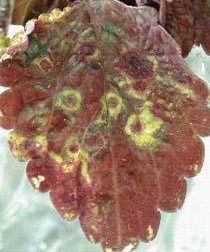 Impatiens Necrotic Spot
Impatiens Necrotic Spot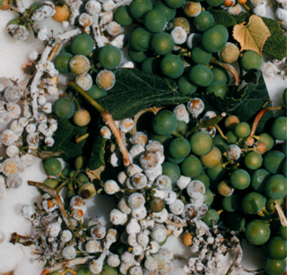 Downy Mildew
Downy Mildew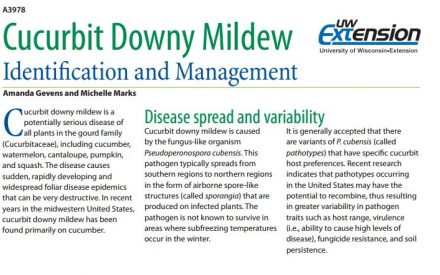 Cucurbit Downy Mildew: Identification and Management
Cucurbit Downy Mildew: Identification and Management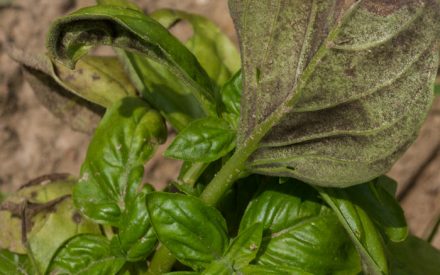 Basil Downy Mildew
Basil Downy Mildew


